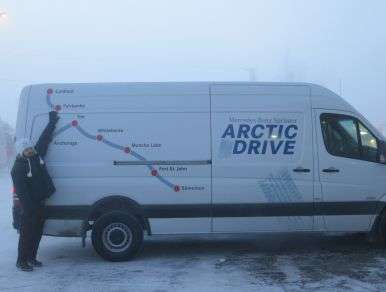Recent Articles
Popular Makes
Body Types
2013 Mercedes-Benz Sprinter Arctic Drive - Extreme Weather Testing for The Silver Star's Flagship Van
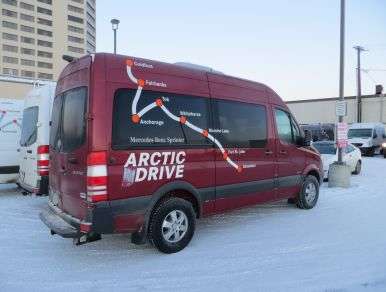
Extreme cold-weather testing.
This simple sentence strikes fear into the hearts of diesel-engine vehicle manufacturers across the industry, which makes it all the more impressive that I was flown to Anchorage, Alaska by Mercedes-Benz in order to put the 2013 Mercedes-Benz Sprinter van through what could only be described as a 1,200 mile torture test that will stretch to the Arctic Circle and beyond.
In fact, the nine vans that made up our Sprinter convoy had already been forced through the wringer once, having recently completed the first leg of what Mercedes-Benz labeled the Sprinter Arctic Drive. Over the course of almost a week these hard-working passenger and cargo models had been driven from Edmonton, Alberta to Anchorage through mountainous terrain and snowy, freezing temperatures. It fell onto us to finish their brutal journey by punishing them with weather that the vast majority of Sprinter owners will never, ever have to deal with.
A Motley Crew Of Vans
Mercedes-Benz arrayed for us, a group of roughly 30 journalists and support team members, a group of Sprinters that provided a full sampling of the current product line-up. The Mercedes-Benz Sprinter, which goes head-to-head with vehicles like the Ford E-Series, the Chevrolet Savana and GMC Express, and the Nissan NV, is available in passenger and cargo editions, along with two different wheelbases (144-inches and 170-inches). Advantages counted by the Sprinter include a tall roof height that allows for most adults to stand up straight inside its rear compartment as well as an efficient turbodiesel drivetrain that returns just under 25-mpg during highway cruising.
A pair of passenger models, a couple of 144-inch cargoes, and a sizable clump of 170-inch long-wheelbase cargo editions – all riding on 2500 series three-quarter ton platforms – were waiting for us in Anchorage when we arrived. I elected to sample a 144-inch cargo edition for the duration of the trip, sharing driving duties with Manitoban journalist Paul ‘Willy’ Williamson. Our model’s 3.0-liter turbodiesel V-6 put out 188 horsepower and 325 lb-ft of torque, which was sent to the rear-wheels via a five-speed automatic transmission just like all of the other vehicles in our caravan.
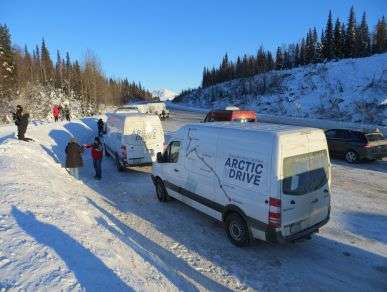
The Haunting Specter Of Low-Temperature Diesel Operation
During the first day’s briefing Mercedes-Benz support personnel made it abundantly clear that we would be facing brutal cold, limited facilities, and the potential that we would have to sleep in our Sprinters overnight should the road from Anchorage to our final destination of Coldfoot, Alaska (accessed via the notorious Dalton Highway) become impassable due to snow, avalanche, or other calamity. They also used the term ‘outhouses’ to describe several of the stopping points we would be taking advantage of during the four-day journey, a term that raised far more eyebrows around the hotel conference room table than the threat of -50 degree F weather.
Why do turbodiesel vehicles in particular quake at the mention of the mercury dropping well below the freezing point? The answer has to do with the unique design of diesel engines, which avoid the use of spark plugs on the way to achieving more efficient combustion by relying exclusively on the compression forces inside each cylinder to ignite the fuel mixture. Attempting to crank over a diesel engine that has been exposed to chilling winds and iced-over climates can often be an exercise in futility as the required compression is impossible to achieve inside the frozen engine block.
Mercedes-Benz was certainly not throwing its Sprinter vans into the Arctic mix unprepared. In fact, significant cold-weather testing was performed during the development of the latest iteration of the vehicles, taking place in northern Sweden and resulting in the introduction of several auxiliary heating systems that not only kept passengers and cargo toasty but which also allowed for the Sprinter’s engine block and coolant to be warmed up as much as 30 minutes prior to it being started via a programmable feature accessible through its dashboard computer system. The fuel filters and BlueTEC emissions fluid were also heated in order to help reduce the chance that the diesel fuel inside the van’s motor would gel as a result of low temperatures.
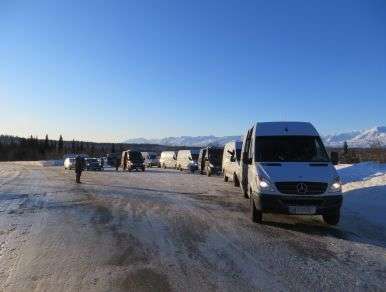
The Alaska Highway Tests Drivers, Machines, And Patience
How did our crew of Mercedes-Benz Sprinters hold up when facing down not just brutal temperatures but also winding, mountainous roads that switched from gravel to asphalt to ice and back again over the space of mere miles? First, I’d like to discuss the van from a handling and ride comfort standpoint.
The route from Anchorage to Coldfoot had us drive through Denali National Park and Reserve, which is famous for being the home of Mt. McKinley (the tallest peak in North America), prior to hitting the Dalton Highway outside of Fairbanks. Absolutely gorgeous views greeted us as we cruised through the Park, but the twisting highway plunged us down brake-testing switchbacks that would just as quickly demand that we pour on the power to maintain our momentum uphill. All of this occurred in very low-traction conditions, with our vans moving from one side of the road to another, lanes-be-damned, in an effort to get as much grip under the Continental winter tires of our Sprinters as possible.
Throughout, the Mercedes-Benz Sprinter proved itself a worthy companion on the Alaska roads. Without the benefit of all-wheel drive (a feature which is offered on several of its competitors) the Sprinter was able to plough forward without swapping the rear end with the front on the ice-glazed tarmac. I found myself constantly working the manual shift feature provided by the van’s transmission so as to reduce speed downhill without having to tempt fate by tapping the brakes, a strategy that proved successful and which greatly reduced the anxiety felt when staring down into the chasms and valleys that regularly presented themselves in front of my vehicle. The Sprinter’s handling was also commendable, as only its billboard-sized bulk catching a crosswind would knock the van off course.
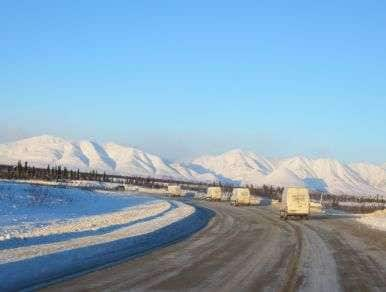
The Perilous Dalton
The Dalton Highway is well known as being one of the most dangerous stretches of road in the world, a barren pathway that cuts through the northern Alaskan interior on the way to the oilfields at Prudhoe Bay. Much of the danger comes from its isolation, which made me thankful that I was in a well-supported convoy lead by expert drivers during the two days I spent sampling its charms, but the condition of the road itself is another consideration when defining its inhospitable nature.
We picked up the Dalton roughly 100 miles out of Fairbanks and I was instantly made aware that the engineers at Mercedes-Benz had paid more than passing attention to the comfort of driver and passenger in addition to the safety of the Sprinter’s cargo. Although our gauges and entertainment options might have been barebones, the vehicle’s suspension system handled most insults with ease and did little to contribute to the fatigue that builds up on long highway jaunts such as this one. That being said, our 144-inch van skittered frost heaves far more than the long-wheelbase editions, which were better able to maintain stability by planting the right foot and summoning the turbocharged engine’s torque.
The Dalton also saw us dodging eighteen wheelers on a regular basis, frequently causing us to move over to the side of the narrow shoulder or stop completely when an oversized load would come barreling down the highway at a speed far exceeding our own. That stretch of road belongs to the overland truckers who ply it on a daily basis; despite the Sprinter’s commercial aspirations, we were mere tourists.
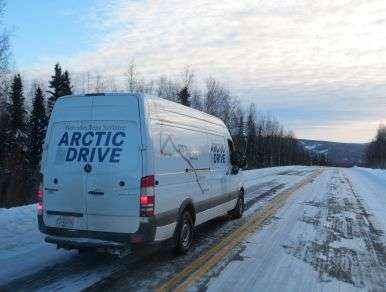
The Killing Cold
Although the Mercedes-Benz Sprinter van was up to the task of handling the blowing snow and slippery, rough road conditions that I piloted it through, it did not fare quite so well with the cold. In fact, the very first night of our journey, a stopover in Fairbanks, revealed just how vulnerable diesel engines are to extreme weather. We converged on the parking lot that morning at 7:30 a.m. to discover that only two of our convoy would start. My own van, its pre-heat system having activated almost three-quarters of an hour prior to my attempt to crank it over, caught and stalled after a mere five seconds of idling, its battery depleted and in need of a jump-start from the thankfully gas-powered Mercedes-Benz GL-Class support vehicle.
Not all of our Sprinters were so lucky. We were forced to abandon a black passenger model in the parking lot of the hotel after a two-hour effort to get it running resulted in nothing but frustration for the team of Mercedes-Benz personnel that converged on it. For the rest of trip – even overnight at the truck stop in Coldfoot where we slept in spartan barracks under the glimmer of the aurora borealis – we left the Sprinters idling at all times, giving them a break only on the fourth and final day of the trip when temperatures had warmed up to more favorable highs.
The cold weather – which we learned had dropped to -59 F in Fairbanks the night one of our Sprinters gave up the ghost – made itself known in other ways, too, throughout the trip. Instances of transmissions and turbos suddenly losing power and having to be reset via a restart in order to come back online occurred from time on the road to Coldfoot and back, and we also dealt with steering systems that became sluggish when the chilling wind whipped through the engine bay and nearly froze the fluid in its lines. Even the sudden appearance of warm front wreaked havoc on our convoy: the warming of the road just south of Denali saw outside temperature rise 20 degrees F to just above freezing in the space of a half-mile, creating slick conditions that caused a semi-truck to lose control and punt a Ford van into one of our own. This scary incident – which, in testament to the safety features of the Sprinter, resulted in no injuries – showed us just how dangerous frontier travel can be no matter how well-prepared one is for potential disaster.
It’s important for me to state that I never expected the Sprinter to shrug off temperatures approaching -60 degrees F without experiencing any ill effects. In fact, few vehicles - diesel or not – can operate in these types of extreme conditions and emerge unscathed. Mercedes-Benz’s previous cold weather testing had prepared the Sprinters for weather of -22 degrees F, which is frigid enough for the majority of the markets where the van is sold. It wouldn’t make sense for the German automaker to engineer a diesel drivetrain capable of withstanding polar winds and the plunging depths of the Arctic night, especially given that we were driving in a region where eighteen-wheelers never shut down their engines unless sitting inside a heated hangar for repairs.
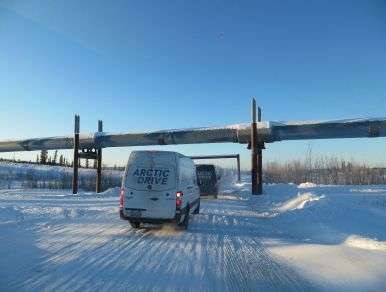
A Sprinter Took Me To The Arctic Circle And Back
I’m writing this from an office where I can look out on the relative warmth of the Montreal winter, which means one very important thing: the Mercedes-Benz Sprinter that I drove took me beyond the Arctic Circle and then back again, no matter how much collateral damage that our convoy had to absorb along the way. The Sprinter is a very competent package, tackling one of the most notoriously rough and dangerous roads in the world without breaking a sweat and bravely idling through the northern night with its tank pumped full of anti-gel and diesel fuel of questionable quality. There’s no reason to expect that it wouldn’t be able to absorb the punishment of a regular work schedule in a more forgiving climate.
And there’s the qualifier. Diesel vans – even well-designed models like the Sprinter that have been fortified against the cold – still aren’t the best option for those who live in areas of the world that are forced to deal with anything approaching extreme temperatures. Gasoline models are definitely the way to go when facing down a chilly winter and a booked-to-the-minute delivery schedule, because in the business world you simply can’t take time off to thaw out your workhorse after a particularly brutal evening outside. The Mercedes-Benz Sprinter is a vehicle that I unhesitatingly recommend for warmer weather customers, but anyone living in the north would do well to consider whether the fuel efficiency of the diesel drivetrain is worth the extra cost of the cold weather equipment – and the potential headaches.
